In the ever-evolving world of online marketing, SEO (Search Engine Optimization) and SEM (Search Engine Marketing) are two prominent strategies for driving website traffic and boosting brand visibility. While both have distinct focuses, determining which is better depends on various factors. This article will delve into the key differences between SEO and SEM, exploring when each strategy is most effective and whether combining both can offer the ultimate marketing advantage.
What are SEO and SEM in simple words?
In simple terms, SEO and SEM have distinct focuses in the world of online marketing. SEO primarily aims to drive traffic from organic search results, while SEM encompasses both organic and paid search efforts to attract website visitors. SEO is all about optimizing a website to rank higher in search engines without paying for ad placements. At the same time, SEM includes strategies to gain visibility through both organic and paid means, such as search ads on platforms like Google Ads.
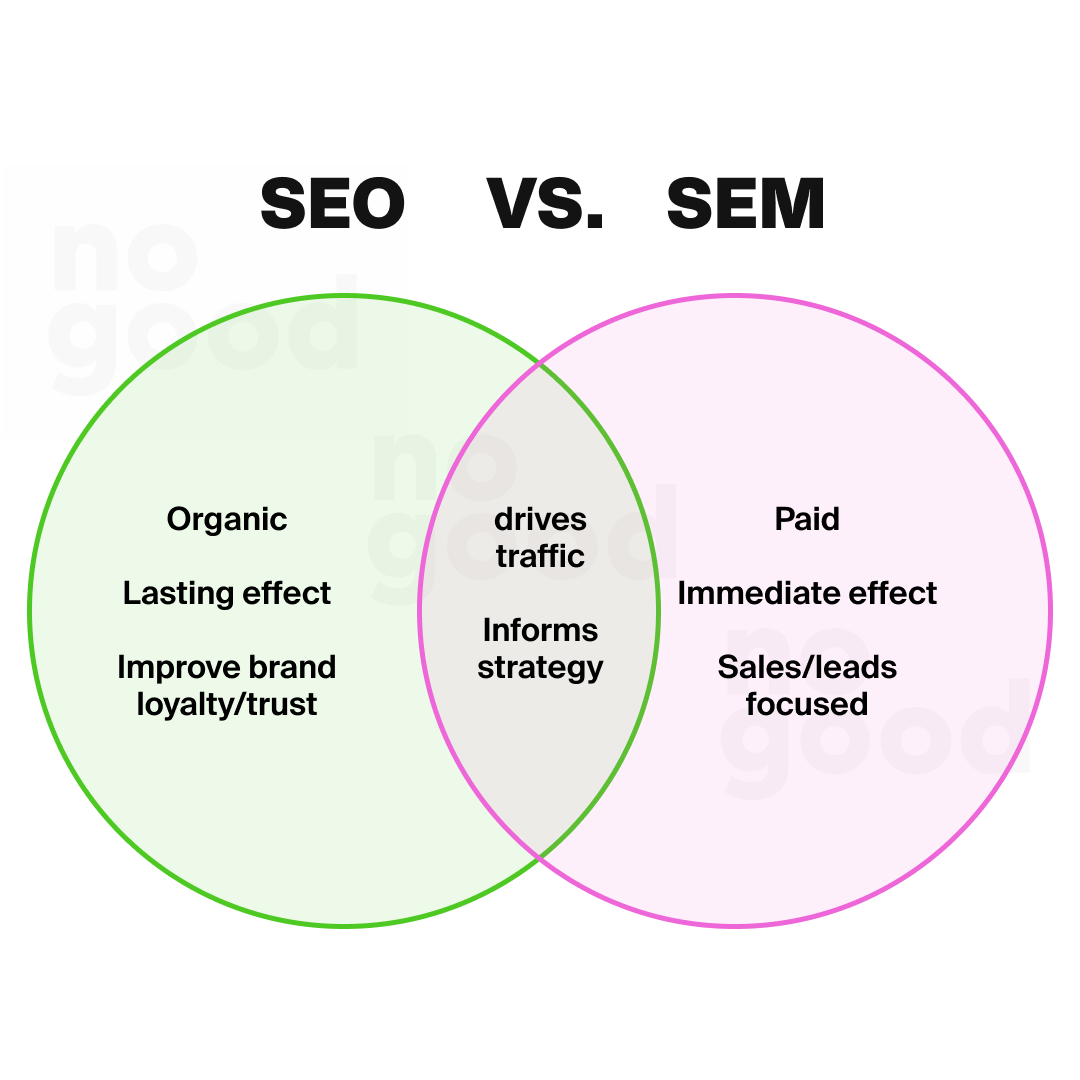
Is SEO a type of SEM?
Yes, SEO is indeed a type of SEM. SEO and SEM are interconnected but have different focuses. SEO is a specific approach within SEM where the primary objective is to concentrate entirely on improving the organic search rankings of a website.
On the other hand, SEM encompasses a broader set of strategies that aim to drive traffic from search engines, utilizing both organic and paid methods. In this comprehensive approach, digital marketers combine SEO efforts for organic results with Pay-Per-Click (PPC) campaigns for paid results.
In essence, SEO and PPC are integral components of SEM, which means that SEO is a type of SEM.
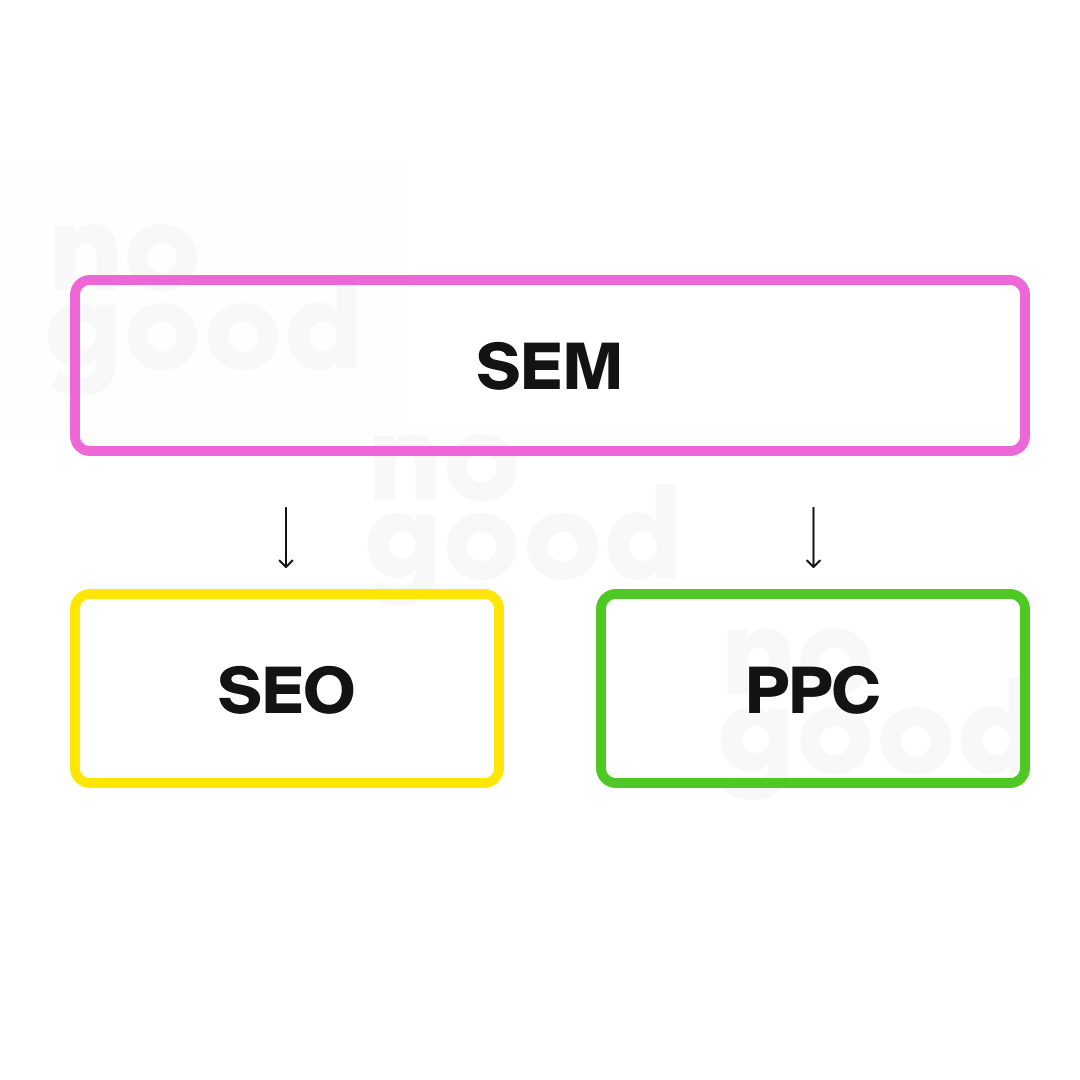
What is the role of SEO & SEM?
SEM encompasses SEO and PPC campaigns, where advertisers pay for their ads to be displayed on search engine results pages (SERPs) and attract immediate traffic through paid clicks. SEM allows businesses to target specific keywords, demographics, and geographic locations, allowing them to gain instant visibility on major search engines.
Ultimately, the combined efforts of SEO and SEM are fundamental to a successful digital marketing strategy. While SEO ensures a website’s organic search visibility and contributes to long-term growth, SEM, including PPC, offers a more immediate and targeted approach to attract users and drive traffic to the site. Integrating SEO and SEM tactics allows businesses to reach a wider audience, maximize their online presence, and effectively achieve their marketing goals.
What are the differences between SEO and SEM?
Search Engine Optimization
- Keyword research: Identifying the search terms people use to find relevant content.
- On-page SEO: Creating content optimized to cater to the needs of searchers.
- Off-page SEO: Establishing trust and authority through links from other reputable websites.
- User interaction: How visitors engage with your site plays a pivotal role in Google’s assessment of its relevance to users’ search queries.
- Technical SEO: Ensuring search engines can easily discover, crawl, and index your web content.
Keyword Research
SEO keyword research is a critical process in search engine optimization aimed at comprehending the specific words and phrases that potential customers use when searching search engines. Digital marketers and SEO specialists gain valuable insights into their target audience’s language and search queries by delving into keyword research.
Keyword research aims to identify and prioritize relevant and high-traffic keywords that align with a website’s products, services, or content. Using effective keyword research tools and techniques, digital marketers can discern the search intent behind user queries and discover the most popular and relevant keywords that users frequently type into search engines like Google.
This process provides valuable data on the search volume and competition for each keyword and uncovers long-tail keywords and related phrases that might be less competitive but highly targeted. Integrating these targeted keywords into a website’s content, meta tags, headings, and other relevant elements enables search engines to understand better the website’s relevance to users’ search queries.
Moreover, SEO keyword research is an ongoing and dynamic endeavor as search trends, user behavior, and industry terms may evolve. As such, digital marketers regularly update their keyword research to ensure their website remains optimized for the most current and relevant keywords. This allows them to maintain a competitive edge and attract organic traffic from users actively seeking products, services, or information related to their business. By consistently refining and adapting their keyword strategies based on research data and analytics, businesses can enhance their organic search visibility, boost website traffic, and achieve higher conversion rates.
On-Page SEO
On-page SEO entails optimizing your website’s content around keywords your target customers use in search engines. It involves practices such as including the main keyword in the title tag, meta description, and webpage URL. Additionally, on-page SEO focuses on creating high-quality, user-friendly content that addresses search intent and organizing it with headings and subheadings. By following on-page SEO best practices, websites can improve their search engine rankings, attract relevant organic traffic, and enhance the overall user experience.
Off-Page SEO
Off-page SEO involves activities outside your website to demonstrate to Google that your pages merit higher rankings. Creating high-quality backlinks is a crucial aspect of off-page SEO and is ranked among the top three factors by Google when determining search rankings. Backlinks serve as votes from other websites, indicating their endorsement of your content.
For instance, if this article receives backlinks from reputable SEO-related websites, it signals to Google that our content is endorsed by industry peers, potentially increasing its ranking value. By actively pursuing high-quality backlinks from authoritative sources, websites can bolster their credibility, improve search engine rankings, and gain broader visibility in search results.
User Interaction
User interaction signals are critical in determining your page’s relevance to users’ searches. Google monitors how users interact with your site to gauge its suitability for their queries. A high bounce rate may indicate that your page doesn’t sufficiently address their needs, potentially leading to lower organic rankings or even exclusion from the first page. Ensuring positive user interactions and delivering valuable content aligned with search intent is crucial for optimizing search engine rankings. By prioritizing user satisfaction and engagement, you can enhance your website’s performance, improve organic search visibility, and achieve better rankings on SERPs.
Technical SEO
Technical SEO optimizes your website for efficient crawling and indexing by search engines. It ensures pages are accessible, loading quickly, and employs a well-structured site architecture. By addressing these technical aspects, your website gains better visibility, user experience, and potential for higher rankings in organic search engine results.
Pay-Per-Click
- Keyword research: Identify customer search terms.
- Bid setting: Determine click payment amount.
- Ad creation: Develop a compelling and relevant ad.
- Audience targeting: Select the desired ad viewers.
Keyword Research
Google Ads keyword research involves more than just discovering customer search terms. It also entails investigating the potential costs associated with different keywords, as the ad expenses can vary depending on the chosen keywords.
For example, here you can see that the average cost-per-click (CPC) is higher for the keyword “marketing agency” than it is for “marketing agency in San Francisco.”

Bid Setting
In bid setting, you determine the amount you will pay Google for each ad click. If competitors outbid you and offer equally or more relevant search engine ads, Google might display your ad less frequently, resulting in fewer clicks for your campaign.
Ad Creation
Ad creation involves content creation and crafting the destination for your ad. Google assigns a quality score to gauge its relevance and usefulness. Ads with high-quality scores achieve broader visibility and incur lower click costs, as they are more likely to be seen by a larger audience.
Audience Targeting
Audience targeting involves choosing the specific audience for your ad. This allows you to target people based on demographics, interests, locations, and other relevant criteria to ensure your ad reaches the most relevant and engaged potential customers.
How are SEO and SEM The Same?
SEO and SEM may have different approaches to engaging customers and search engines, but they share significant similarities:
- Both SEO and SEM are integral in elevating brand awareness. Employing targeted marketing alongside focused SEO attracts both paid and organic visitors, resulting in increased visibility and credibility for the business.
- Search engines serve as the common ground for both SEO and SEM strategies. While SEM involves paying for relevant consumer redirects to the brand’s site, SEO leverages keywords to optimize website visibility in organic search results. SEM guides users directly from search pages to the brand’s landing page, while on the other hand, SEO naturally attracts users to a particular website.
- The skills utilized by specialists in both fields overlap considerably, albeit with varying applications. Critical thinking, data analysis, research, and communication skills are essential for both SEO and SEM professionals to ensure effective brand targeting and a successful online presence.
SEO vs. SEM: How long does it take to see results?
When comparing aspects of SEO and SEM, one of the main distinctions lies in their speed of delivering results.
SEO is a time-consuming process, particularly for new websites with limited backlinks. On average, it takes about 2 years to rank on Google’s first page, with many top-ranking pages published over 3 years ago. However, some results can be seen within a few months by targeting long-tail keywords and implementing SEO best practices.
On the other hand, SEM, especially through PPC efforts, can yield almost instantaneous results. Running an ad can generate traffic and conversions within hours. However, achieving a positive return on investment (ROI) from PPC may require months of testing and optimization.
PPC provides quicker results than SEO, making it more suitable for immediate traffic and conversions. Conversely, SEO demands patience and long-term investment but substantially benefits organic visibility and sustainable growth over time.
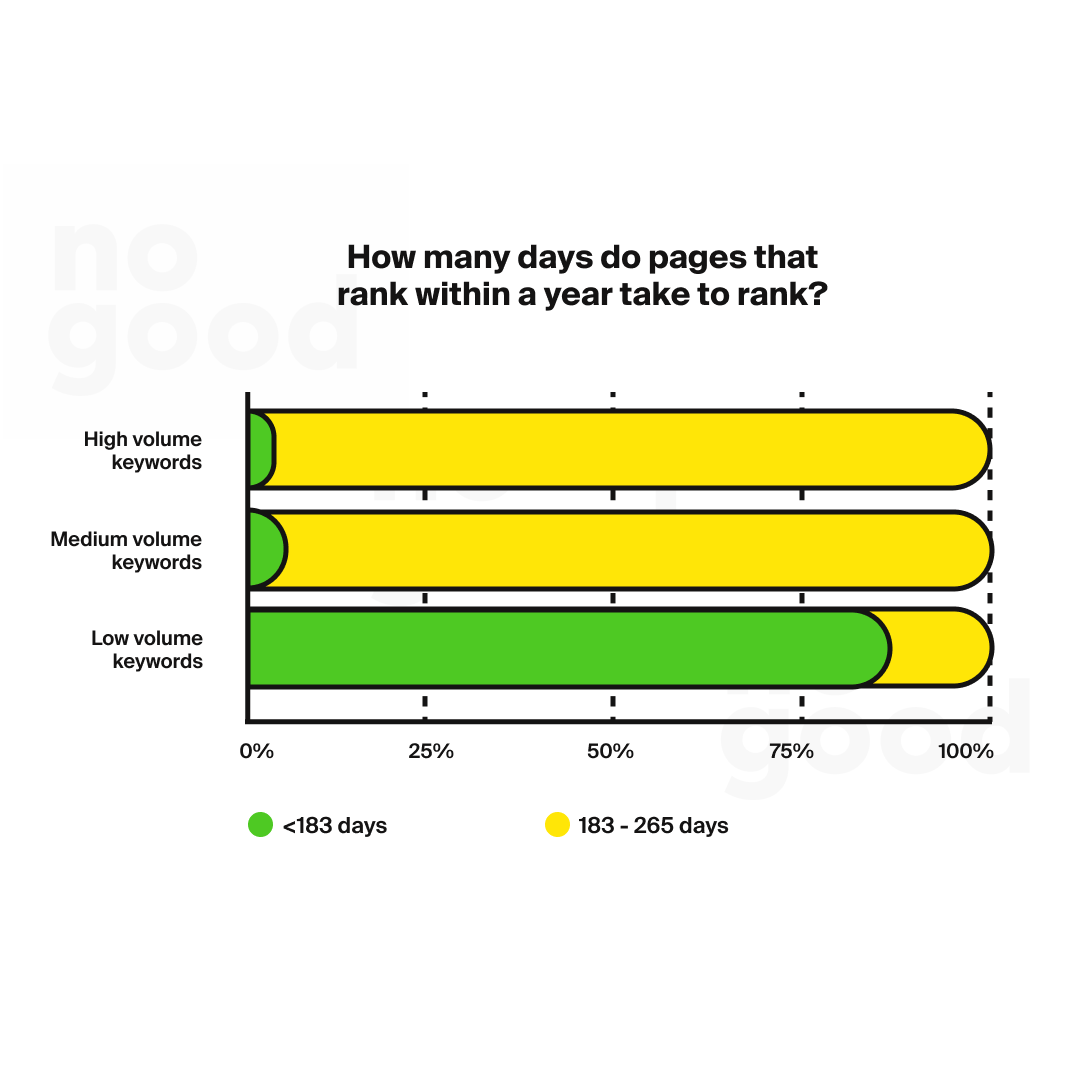
How much does SEO vs. SEM cost?
The cost of both SEO and SEM varies depending on the approach taken.
With SEM, specifically through PPC, immediate costs are involved as each click incurs charges. While it guarantees results, it requires upfront spending and can become expensive, especially for competitive keywords with high CPC rates.
On the other hand, SEO, although seemingly “free” once you rank, demands significant time, effort, and financial investment upfront. Achieving rankings involves investing in SEO tools, content creation, graphic design, coding, and deployment. While the costs are incurred during the optimization process, once a website ranks, it can maintain visibility with minimal ongoing expenses.
Overall, both SEO and PPC have pros and cons regarding cost. Many businesses adopt a marketing strategy that combines both approaches to leverage the strengths of each. While PPC offers immediate results, SEO can provide long-term benefits with sustained organic traffic once rankings are achieved. Finding the right balance between the two can yield an effective marketing campaign that maximizes ROI and drives continuous traffic to the website.
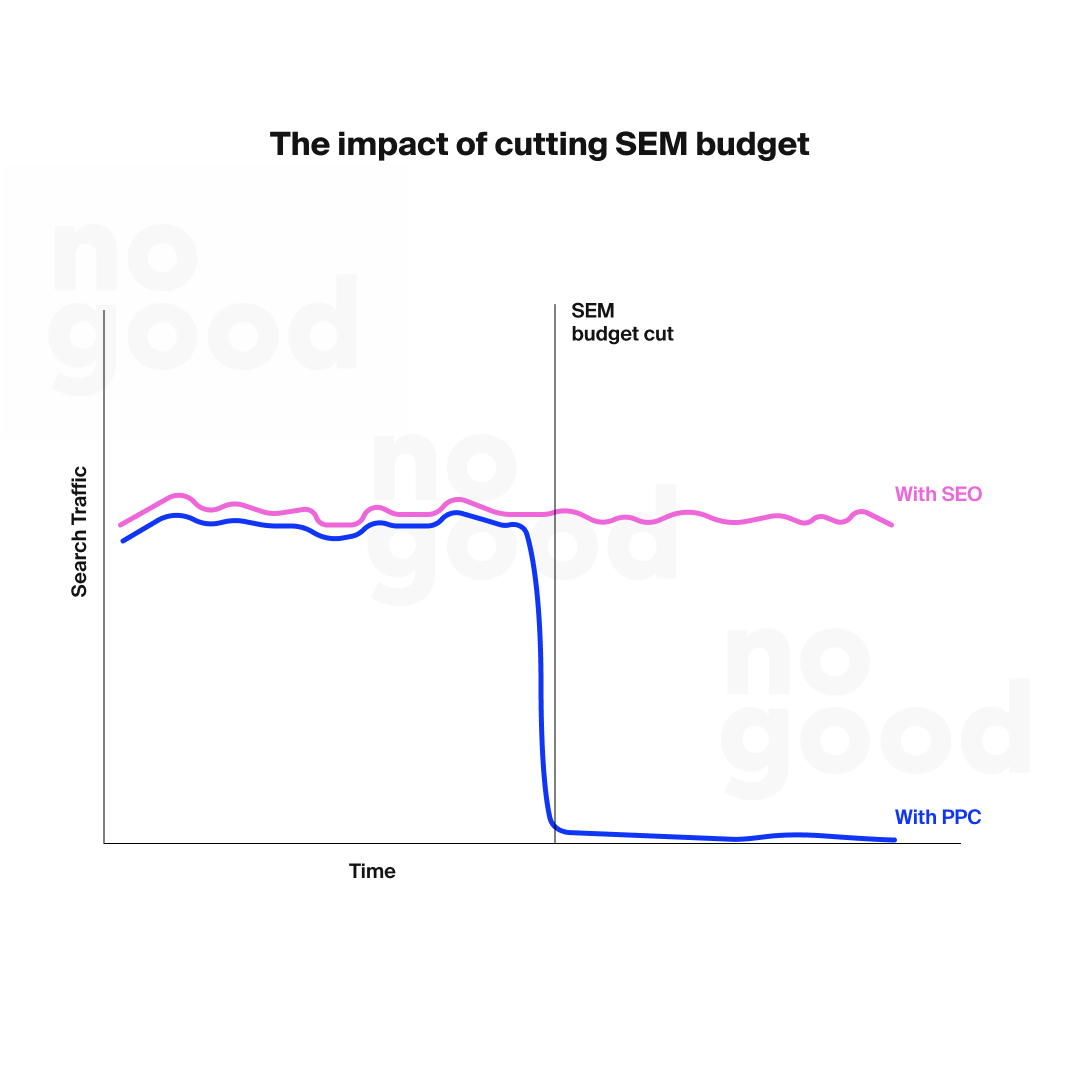
Is SEO or SEM Better?
When deciding between SEO and SEM (PPC), it’s essential to consider the specific keyword and the overall marketing strategy. Here’s a flowchart to help guide the decision:
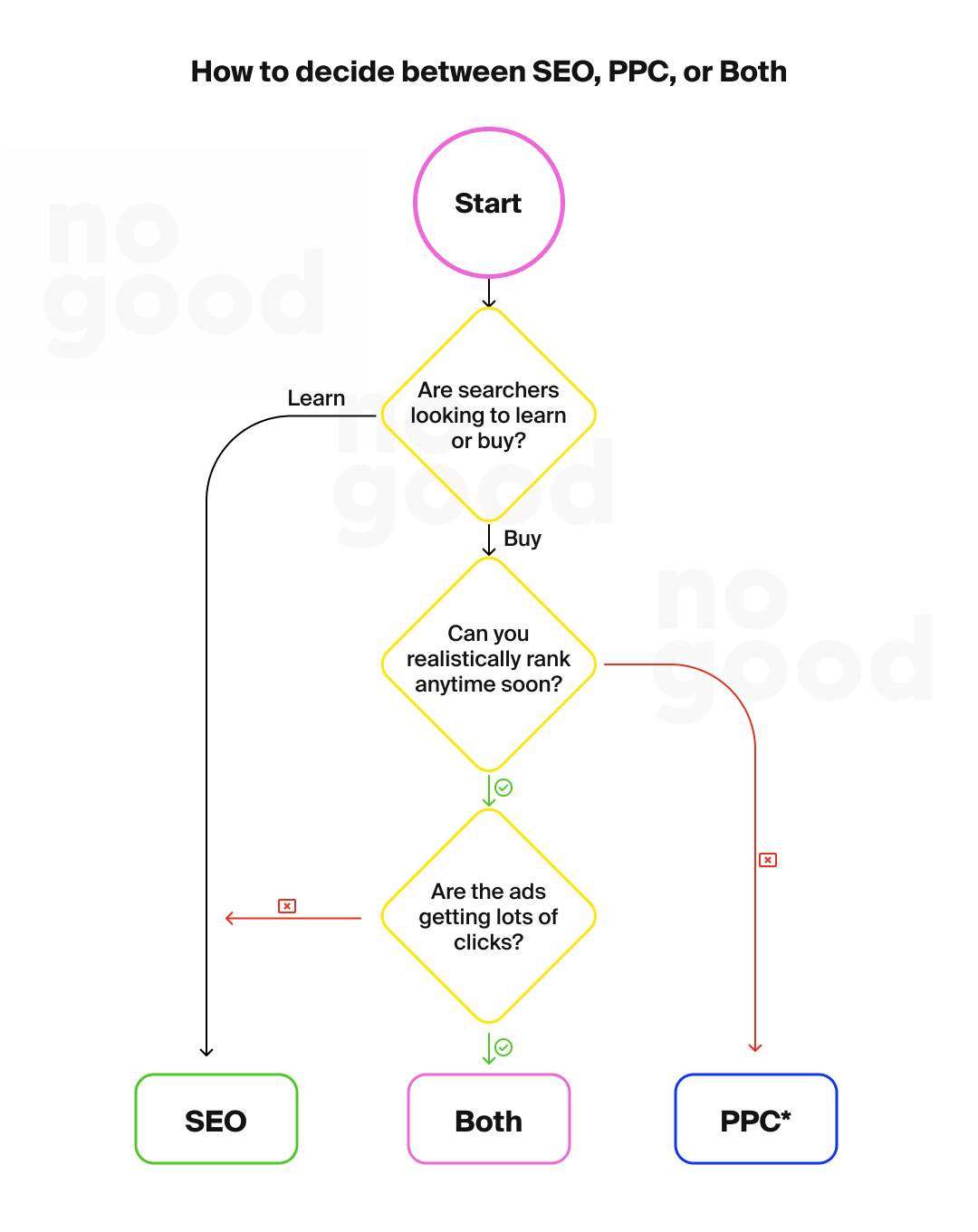
- SEO is best for informational keywords, where users are seeking to learn rather than make an immediate purchase. It works effectively for keywords where organic traffic is likely to convert over time.
- PPC is ideal for “hard to rank for” keywords that may take years to achieve high organic rankings. It offers immediate traffic and allows for testing and optimization for conversions.
- A combination of PPC and SEO works well for ad-heavy keywords, maximizing visibility and driving traffic from both paid and organic sources.
Here is a more detailed breakdown to help you decide which is better, SEO or SEM:
When to Focus on PPC:
- Ad budget: Set a strict budget for PPC ads to avoid overspending. However, managing a Google Ads account requires expertise and continuous optimization to achieve desired results.
- Managing an Adwords account: PPC may seem simple, but effective management involves considering keyword targeting, ads, Quality Score, ROI, and conversion rates.
- Launching and testing of landing pages: For optimal PPC performance, targeted landing pages or ad groups are essential. Conducting A/B tests helps identify high-performing pages.
When to Focus on SEO:
- Limited budget: If you lack a significant marketing budget, focusing on SEO is preferable, as it can yield long-term benefits without quickly depleting funds like PPC ads.
- You’re able to rank for informational keywords: For businesses with the ability to create exceptional content, targeting informational keywords can attract substantial search volume through SEO.
- Time is on your side: SEO and content marketing require time to gain momentum. If you’re willing to be patient and wait for results to build over 6-12 months, SEO is a suitable choice.
When to Do Both (SEM):
- If you have sufficient resources: Managing both SEO and PPC requires ample resources. If your team can handle both effectively without sacrificing quality, integrating both strategies can be advantageous.
- When SEO and PPC are not overwhelming: A combined strategy can be beneficial if managing both SEM components doesn’t overwhelm your team or dilute the focus on either approach.
How Do SEO and SEM Work Together?
SEO is best for informational keywords where people want to learn rather than buy, as PPC may not generate enough conversions for a positive ROI.
PPC is an effective short-term SEM strategy for “hard to rank for” keywords, as it provides instant traffic and allows for testing and conversion optimization.
Using PPC, businesses can obtain valuable keyword data, informing their SEO strategy for targeting high-converting keywords.
The choice between SEO and SEM (PPC) depends on the specific keyword and its potential for conversions. An integrated approach that combines both SEO and PPC can be advantageous, leveraging the strengths of each strategy and achieving a balanced marketing campaign. Ultimately, businesses should assess their goals, budget, and target audience to determine the most suitable SEM strategy for their specific needs.
Understanding the differences between SEO and SEM allows businesses to make informed decisions on their marketing strategies. Both approaches have unique benefits, and the optimal choice depends on the business’s specific goals, budget, and target audience. While SEO offers sustained growth and long-term visibility, PPC delivers immediate traffic and measurable results. Ultimately, a well-balanced marketing strategy combining SEO and PPC can yield the most effective results in today’s competitive digital landscape.




